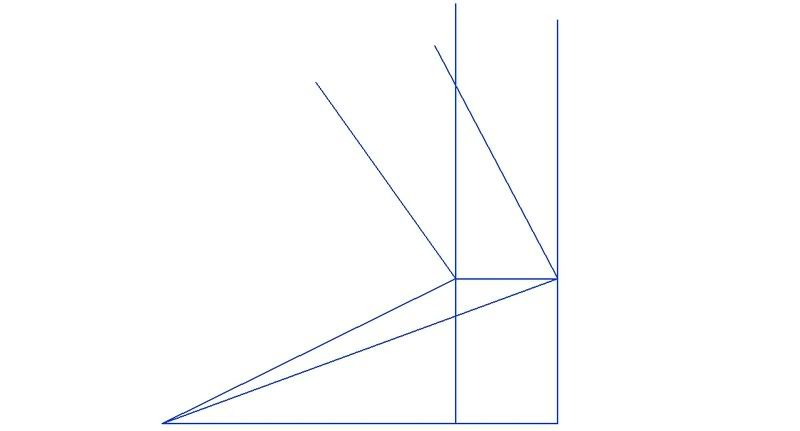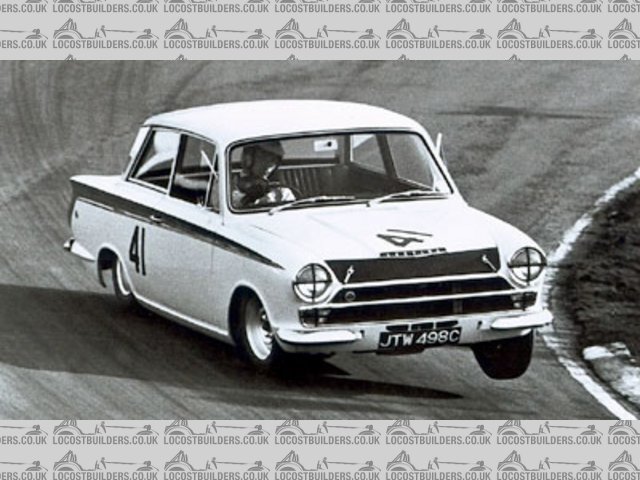Im looking for 85% ackermann geometry, can anyone describe to me what this actually relates to?

Cheers
Colin

Hi guys, looking into suspension geometry. Ive drawn my 100% ackermann angles as shown below. I understand only london taxis use 100% ackermann
geometry.
Im looking for 85% ackermann geometry, can anyone describe to me what this actually relates to?

Cheers
Colin
A) Named after Rudolf Ackerman, this angle defines the correct angle that steering wheels must have to effeciently negotiate a turn. In a standard
turn, the wheel on the inside of the turning radius must follow a more severely curved line than the outside wheel. By setting steering arms, one can
successfully adjust the turning angle so that the inside tire turns at a larger angle than the outside. This results in better traction around the
turn.
B) Ackerman angle is the angle of the king post which holds the hub, the angle is the verical displacement of the top of the king post rearwards, the
inside turning wheel will effectivly move in a smaller radius than the outside wheel, this angle also helps in the self centering of the steering in a
straight line.
http://www.rcuniverse.com/community/glossary.cfm?letter=all&
amp;key=Ackerman%20Angle
quote:
Originally posted by jos
B) Ackerman angle is the angle of the king post which holds the hub, the angle is the verical displacement of the top of the king post rearwards, the inside turning wheel will effectivly move in a smaller radius than the outside wheel, this angle also helps in the self centering of the steering in a straight line.
http://www.rcuniverse.com/community/glossary.cfm?letter=all& amp;key=Ackerman%20Angle

sorry i cant attach an image.
please see "rack opinions5.jpg"
in my photo archive.
quote:
Originally posted by redscamp
sorry i cant attach an image.
please see "rack opinions5.jpg"
in my photo archive.
I'll have a go.....
If you had beam axles... and if the track rod were behind it, then for 100% ackermann, a straight line frome the CENTRE of the back axle through the
track rod ends (where it joins the steering arm) would continue to intersect the steering axis.
This gives an excellent first approximation to getting the inner front wheel to turn more than the outer one in a corner.
'course with wishbones & racks it's a little more complex...
0% ackermann is when the lines from the steering axis through the track rod ends are both parallel & going straight back.
Bob
PS I believe Ackermann himself was the UK patent agent for a german guy who sussed the geometry - it was invented for stagecoaches.
Ackerman was actualy a publisher who gave his name to a principal developed by Lankensperger, this was modified in 1878 by Jeantend. If you use the principal of centre of back axle through the steering pivots, it makes no allowance for tyre slip, so it's actualy wrong, (was fine for steel shod coach wheels). Plus this amount of Ackerman make hige speed motoring a bit dodgy. Most modern, (high speed), cars use zero or even negative Ackerman. To give a reasonable compromise set up the Ackerman to be twice the wheel base, which does give some allowance for tyre slip. HTH Ray
Don't bother with Ackerman. as it's not needed
It was needed when tyres were solid. Modern tyres need a slip angle to generate grip and today many high performance cars use anti-ackerman principles
instead.
Anti-ackerman is bad news, the theory behind it is good in that it should make better use of the tyres by giving the correct slip angle on the inside
front wheel for the tyre vertical load at the limmit of adhesion ---- but it gives more problems than it is worth.
Some ackerman is require for good turn in and cornering below the limit of adhesion, how much is the question 10% ? 20% ? 40% ? 50% ?
As as already been pointed out with a steering rack conventional ackerman point diagrams don't hold true because of conflict of arcs.
I read that Ackerman was designed for horse drawn carriages. There were complaints about the ruts that they carved into rich mansion owners'
gravel drives when 'u turning' .
I'm full of useless info like that 
I think a small amount of Ackerman is good for general road use and possibly for racing too. True 100% Ackerman will only be noticed on full lock
anyway imo so I wouldn't let it take too much of your time - I woud concentrate on bump steer instead
[Edited on 24-11-07 by RazMan]
Proper Ackerman angles are advantageous on any car, and are used on the high speed cars I've been dealing with. At least it makes the inside tyre
do its fair share of the work. Or that's what the latest, and not so latest, thinking is and has been for some time.
Cheers,
Syd.
I think anyone interested in this subject should see Alan Staniforth's excellent book
"Competition car suspension", particularly chapter 4.
Alan says
"Better to put my cards on the table from the very beginning as a total believer and convert to Ackerman steering angle, one of the very few
things in the four-wheeled vehicle that is self-adjusting to the precise demand of varying circumstances with highly valuable pluses, forgiving and
flexible in application, relatively easy to fit and forget, needing neither further adjustment nor lubrication and search as one may, no awful
negative to weigh against it's installation."
I can't add anything beyond this and the other posts in here regarding how it's worked out (The book has many graphs and diagrams), but it
does seem to me that it's "something for nothing" and you don't get that very often.
Just my 2p's worth

Cheers
Chris
How much or how little ackerman depends on a few variables the ones I can think of are tyre characteristics, aero down force and roll couple
distribution.
Tyre characteristics aren't generally available but a rule of thumb would be if the tyres are lightly loaded ie a lot of rubber in relation to
the weight the tyres support then you need a higher % ackerman.
If you have a lot of aero down force then the % ackerman should be very high.
Roll couple distribution is easy to visulise if to couter oversteer the front has to be made so stiff at the front that it almost lifts the inside
front wheel when cornering at the limit then the % ackerman should be low.
[Edited on 25/11/07 by britishtrident]


Rescued attachment cortina1race.jpg
Thanks for all that guys, plenty to think about there :S
Cheers